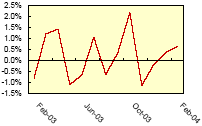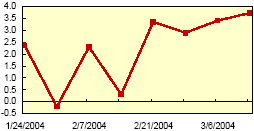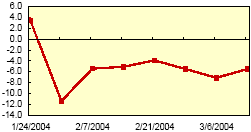



Poultry Outlook Report - April 2003
By U.S.D.A., Economic Research Service - This article is an extract from the April 2003: Livestock, Dairy and Poultry Outlook Report, highlighting Global Poultry Industry data. The report indicates that retail poultry prices are expected to be higher in the second half of 2003 and broiler production forecasts are expected to be lower than last month.
The U.S. poultry industry continues to be rocked by Avian Influenza (AI). There now have been
outbreaks in Delaware, New Jersey, Pennsylvania, Texas, and most recently in Maryland. Due to
the export bans or restrictions by other countries, the forecast for broiler exports was lowered to 4.955 billion pounds.
Based on previous AI outbreaks, it is assumed that their national bans will be regionalized to specific States, provided there are no further outbreaks of AI. Mexico has
already announced that exports from some States can resume. Despite expected lower exports and
increased production in 2004, broiler prices are forecast record high. Prices are expected to
average 69-73 cents per pound this year, compared with 62 cents last year.
Avian Influenza Outbreaks Cloud Trade Outlook
The U.S. poultry industry continues to be rocked by outbreaks of Avian Influenza (AI) in various
States. There have been outbreaks in Delaware, New Jersey, Pennsylvania, Texas, and most
recently in Maryland. The outbreak in Maryland was at a commercial broiler operation and located
where there are a large number of other operations within a relatively short distance. The current
assumption is that the countries currently banning all U.S. poultry shipments will, over time,
eventually target specific States, provided there are no further outbreaks of AI.
The timetable for this regionalization process will vary from country to country. Mexico recently announced that some exports from the United States can resume. There are restrictions on what products specified States can export to Mexico and on the storage of poultry products in Texas before entering Mexico. Due to the number of bans or restrictions placed on the export of broiler products, the forecast for broiler exports was lowered to 4.96 billion pounds from the previous forecast of 5.28 billion pounds.
Broiler Production Rises in January, Production Expected Higher in 2003
|
Composite Broiler Price
Percent change from previous month 
|
Along with the increase in the number of chicks being placed for growout, the average weight of birds at slaughter has been running over 2 percent higher than the previous year. The overall broiler production estimate for 2004 is now 33.93 billion pounds, up 3.6 percent from 2003. Revisions in broiler production contained in the Poultry Slaughter-Annual Summary for 2003 increased total broiler production for 2003, to 32.75 billion pounds, up 1.6 percent from 2002. The increase is due to an increase in the average weight at slaughter, as total broiler slaughter declined slightly.
|
Weekly Broiler Slaughter
Percent change from last year 
|
Prices for other broiler products, more dependent on the exports market, have also moved significantly higher. Leg quarter prices in January and February averaged 34.6 cents per pound, up 73 percent from the same period in 2003. The same pattern can be seen for wings, up 72 percent and thighs, up 32 percent. Even with a forecast of higher production in 2004, domestic broiler prices are expected to remain strong. How strong will depend on both the domestic economy and how quickly other countries relax bans and restrictions on imports of U.S. poultry products.
Turkey Production Seen Down in 2004
|
Retail Turkey Price
Percent change from previous month 
|
The lower poult placements are expected to result in lower turkey production over the first half of 2004. Turkey stocks at the end of January were down 9 percent from the previous year, a wide departure from the beginning of 2003 when they were up over 30 percent. Smaller stocks of both whole birds and parts, along with lower production is expected to gradually strengthen prices over 2004. The outlook for turkey production and prices has been helped by Mexico’s announcement that poultry exports from the United States can resume, under certain restrictions. While no turkey production operations have tested positive for AI they have been under the same trade bans as broilers. Also, Mexico accounts for about 50 percent of all U.S. turkey exports.
Revisions in turkey production slightly raised 2003 production to 5.65 billion pounds, still down 1 percent from 2002. The decrease in turkey production was the result of a lower number of birds being slaughtered, as the average weight was unrevised.
|
Weekly Turkey Slaughter
Percent change from last year 
|
Links
For more information view the full Livestock, Dairy and Poultry Outlook - March 2004 (pdf)Source: Livestock, Dairy and Poultry Outlook - U.S. Department of Agriculture, Economic Research Service - March 2004








